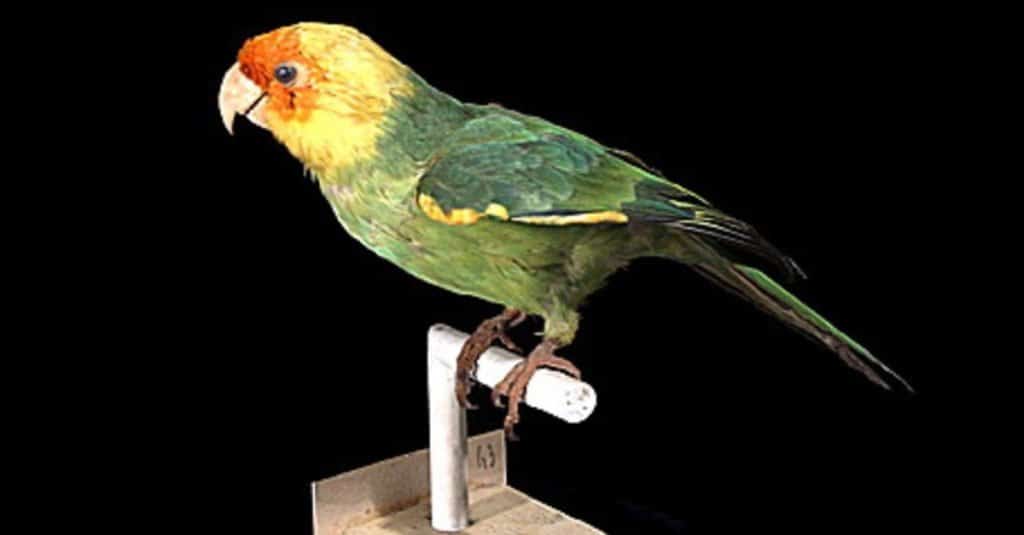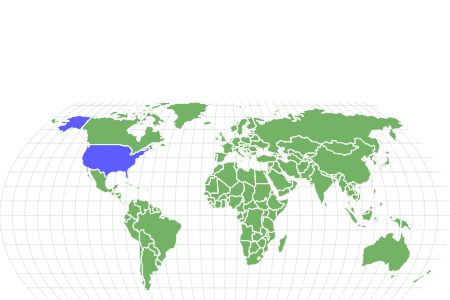The Carolina parakeet is one of the few parrots that lived as far north as the United States
Advertisement
Carolina Parakeet Scientific Classification
- Kingdom
- Animalia
- Phylum
- Chordata
- Class
- Aves
- Order
- Psittaciformes
- Family
- Psittacidae
- Genus
- †Conuropsis
- Scientific Name
- †Conuropsis carolinensis
Read our Complete Guide to Classification of Animals.
Carolina Parakeet Conservation Status
Carolina Parakeet Facts
- Fun Fact
- The Carolina parakeet is one of the few parrots that lived as far north as the United States
- Estimated Population Size
- None
- Biggest Threat
- Hunting
- Most Distinctive Feature
- The brightly colored plumage
- Wingspan
- 21-23in
- Incubation Period
- 23 days
- Habitat
- Woodlands
- Predators
- Birds of prey, raccoons, skunks, squirrels, and snakes
- Diet
- Omnivore
- Favorite Food
- Fruits, seeds, flowers, and insects
- Type
- Bird
- Common Name
- Carolina Parakeet
- Number Of Species
- 1
- Location
- United States
- Average Clutch Size
- 1
- Nesting Location
- Hollowed trees
- Age of Molting
- 18-19 days
View all of the Carolina Parakeet images!
Dazzling in its brightly colored plumage, the Carolina parakeet was one of the few parrot species native to the United States.
Sightings were once fairly common in the east, but population numbers dwindled rapidly over the centuries from a combination of different factors, many of them human-induced but some natural. The last recorded specimen died at the Cincinnati Zoo in 1918 before it was declared officially extinct in 1939. Much of what we know about this species is based on anecdotes or the study of captive or dead specimens.
5 Amazing Carolina Parakeet Facts
- The Carolina parakeet had two distinct subspecies. There is still some debate about the natural range of each subspecies, but there was apparently very little overlap between them.
- The Carolina parakeet was an expert climber. One of the more amazing facts is that its beak functioned as a kind of third limb to navigate the branches and trunks of trees.
- Carolina parakeets could be incredibly noisy. Entire flocks were sometimes heard from miles away.
- Since the Carolina parakeet ate the toxic seeds of the cocklebur, it’s been suggested that this bird may have been poisonous. John J. Audubon himself noted that some cats apparently died after eating this parakeet.
- The Carolina parakeet is considered to be a potential candidate for de-extinction. This is the process of bringing back an extinct species from pieces of DNA. The bird’s genome was sequenced in 2019.
Where to Find the Carolina Parakeet
The Carolina parakeet was once found across parts of the eastern United States. Woodlands next to swamps or rivers were its preferred habitat. There is still some debate about its true range, however. It was once believed that the fringes of its natural habitat extended as far west as Colorado and as far north or east as New York. But this map was based upon only a few known historical sightings in certain states. A reconstructed map from 2017 suggests a more constricted range. One subspecies probably inhabited Florida and the surrounding coasts, while the other subspecies were shifted toward the interior of the United States, from Kansas to Ohio.
Carolina Parakeet Nests
This species constructed its nest in small tree hollows out of basic plant materials.
Carolina Parakeet Scientific Name
The scientific name of the Carolina parakeet is Conuropsis carolinensis. Carolinensis is obviously a Latin version of Carolina. The genus name Conuropsis, of which this species was the last living member, appears to derive from the term conure, which describes several species of small to medium-sized parrots. Some people use conure and parakeet interchangeably to mean the same thing, but conure is a bird-keeping term more than an actual scientific term. This species belonged to the family of true parrots, Psittacidae, which also includes the iconic Scarlet macaw.
Carolina Parakeet Size, Appearance, and Behavior
When it was still alive, the Carolina parakeet could claim to be one of the most colorful native birds in all of the United States. They had bright green or blue plumage on the body, yellow around the neck, and red or orange around the face. Males were slightly larger than females, potentially measuring nearly 14 inches from head to tail, but otherwise, their plumage was exactly the same. This species also had a big, sharp beak, well-adapted for cracking open nuts and seeds.
Carolina parakeets traveled in flocks of 100 to 1,000 birds at a time. They were not known to be migratory over long distances, since they mostly stayed within 30 miles of their home range, but some populations may have moved around slightly to cope with the harsh winter. Social cohesion was an important aspect of their behavior. They were known to engage in mutual preening and scratching to reinforce their bonds with each other and keep clean. Foraging for food occurred near the onset of sunrise and sunset, while most of the daylight hours were spent resting, roosting, and bathing.
The Carolina parakeet was known to emit a harsh shrill as a warning call in the presence of nearby predators. It was mostly silent while roosting, but it did make quite a loud cacophony of noises while in flight.

©Naturalis Biodiversity Center / CC BY-SA 3.0 – Original / License
Carolina Parakeet Diet
The Carolina parakeet was an omnivorous species. It held food in place with its claws and tore it apart with the beak.
What does the Carolina parakeet eat?
The Carolina parakeet consumed the fruits and seeds of many different plants and trees, including the beech, elm, sycamore, maple, oak, and pine, which it then supplemented with insects for extra protein, but the cocklebur appeared to be their favorite food. Carolina parakeets also apparently consumed salt licks and possibly saline water in order to add a bit of salt to their diet.
Carolina Parakeet Predators, Threats, and Conservation Status
This parakeet is completely extinct in the wild. Deforestation and hunting are blamed as the primary culprits; the arrival of European settlers marked the beginning of the end for them. But the spread of diseases and other natural problems may have played a secondary role as numbers declined and the species became more susceptible to negative shocks.
What eats the Carolina parakeet?
This parakeet was preyed upon by hawks, eagles, and other birds of prey. Eggs and chicks were often the targets of raccoons, skunks, squirrels, and snakes.
Carolina Parakeet Reproduction, Young, and Molting
Many facts about the bird’s reproductive habits were poorly documented at the time. Some contemporary sources claimed this species was monogamous, but there were also reports that multiple birds shared nests together. What we do know is that the Carolina parakeet mated in the spring and produced between two and five eggs at a time.
The chicks were born with entirely green plumage and pale underparts. After about 20 days, the young parakeets would gain their full-flight feathers and be ready to fly. It was believed that both parents played an important role in raising and feeding the young. After a year, the young parakeet would develop its adult plumage and become sexually mature. The species was relatively long-lived. It could survive up to 30 years in captivity.
Carolina Parakeet Population
No members of this species are currently alive today. Because of deforestation, hunting, and other factors, it entered a precipitous period of decline in the 18th and 19th centuries from which it never could recover. By the end of the 19th century, populations appeared to be in a state of total collapse. The last known member of the species died in 1918.
View all 235 animals that start with CCarolina Parakeet FAQs (Frequently Asked Questions)
Does the Carolina parakeet migrate?
This species never traveled very far from its home, but there may have been some slight seasonal movement during the spring and fall.
How many eggs does the Carolina parakeet lay?
This species laid two to five eggs per clutch.
How fast does the Carolina parakeet fly?
The flying speed is unknown. It was never recorded while the bird was still alive.
What is the Carolina parakeet’s wingspan?
This species had a large wingspan of 21 to 23 inches.
When do Carolina parakeets leave the nest?
Chicks began to fledge a mere three weeks after hatching. They were effectively independent after learning how to fly.
What killed the Carolina parakeet?
Deforestation was no doubt a significant cause in its decline, and some natural factors may have contributed, but the single most important factor was probably hunting. This was done both for sport and for commercial purposes (their feathers adorned clothing), but also as a kind of deliberate extermination. Carolina parakeets were highly attracted to farmers’ domesticated fruit crops, which they would sometimes ruin in the process of plundering. In order to protect their crops, farmers would shoot the parakeets in the act of feeding. This species had the unfortunate tendency to approach a fallen flock mate, and so farmers would end up extinguishing several birds at once. At the same time, it was acknowledged that the parakeet did have positive effects by controlling the spread of the invasive cocklebur. Deforestation probably did fragment and disrupt populations, but it’s debated just how much of a role it played since nest sites were still widespread.
Is the Carolina parakeet really extinct?
Yes, the last confirmed sightings of a wild Carolina parakeet occurred in 1910.
Can the Carolina parakeet be brought back?
De-extinction is certainly a technical possibility. Usable DNA has been extracted and sequenced from the remains of a long-dead Carolina parakeet. One suggestion is to take a few members of the closely related sun parakeet and modify their genome to resemble the Carolina parakeet. But even as the technology progresses to bring back identical animals from fragments of DNA, people will inevitably debate the wisdom of de-extinction.
Thank you for reading! Have some feedback for us? Contact the AZ Animals editorial team.
Sources
- Animal Diversity Web / Accessed June 20, 2021
- Audubon / Accessed June 20, 2021
- BBC News / Accessed June 20, 2021


















